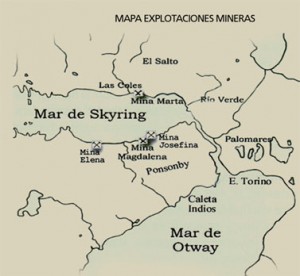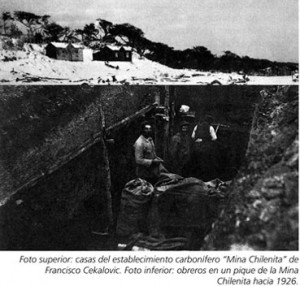History of Coal in Magallanes

“The presence of lignite coal was known in the Magellan territory since the beginning of the Chilean colonization in the region of the Strait of Magellan. The first efforts failed and the same happened elsewhere in this vast territory, until the late nineteenth century. Only at the beginning of the twentieth century coal mining regained its vigor, with investment by Chilean businessman Agustin Ross in the river of the Valle de las Minas (Valley of the Mines) near Punta Arenas (mina Loreto).
The activity spread to another regional district, mainly in Riesco Island (mina Elena). Thus coal mining reached a climax period by 1943, especially fueled by coal exports to Argentina. Since 1950 and for the next 30 years, the coal activity decayed to lose all its economic importance. However, since 1984 a second production period began with modern technology and strong capital investment, allowed the exploitation of the site Pecket (northern district of the peninsula of Brunswick) since 1987, reaching a peak of 1,262,847 tons. Since 1998 the annual production exceeds an average of 300,000 tons and a renewed coal development waits the initiation of new productive sites in Riesco Island …”
(Mateo Martinic Beros, National Prize of History)

Back in the memory as if time was a recorder and stopped in 1584, date of the first initial detection of the presence of fossil coal in the region, is to be reunited with the history of the Spanish Captain Pedro Sarmiento de Gamboa.
By then he was ahead the first steps in the colonization of the Strait of Magellan coastline. In his expedition he found large numbers of black stone, his words were consigned to King Philip II as follows: “… thrown into the fire, burning in the fire as oil for a long time, better than the coal in France”..
Later other travelers will repeat this finding. The naturist Bernardo Philippi and the sailors of the Goleta Ancud, in 1843 were surprised by the remains of coal in Punta Santa Ana
 A handful of dreamers opened the bowels of the earth and gave life to the coal boom in Riesco Island. It wasn’t easy. The list of failed attempts far exceeds the successes. Only the determination of this visionary pioneers allowed the start of the first coal explorations in Riesco Island.
A handful of dreamers opened the bowels of the earth and gave life to the coal boom in Riesco Island. It wasn’t easy. The list of failed attempts far exceeds the successes. Only the determination of this visionary pioneers allowed the start of the first coal explorations in Riesco Island.
The French immigrant, Jorge Meric discovered the deposits of the Magdalena mine, starting its operation in 1897, in partnership with local entrepreneurs Mauricio Braun and John Blanchard. It was a short campaign, followed by other precarious and low production ventures.
In 1918, the Norwegian engineer Ove Gude, discovered mantles of better quality. The finding provided a mining takeoff that met, in part, the energy needs of Punta Arenas, with regular exports to the Argentinean Patagonia. Mina Elena and Josefina carried the brunt of the carboniferous success in the region.
In addition to the above, two other sites in the Riesco Island were exploited during the 1920s: Mina “Chilenita” developed by the company formed by Jorge Ihnen and Francisco Cekalovic and “Tres Hermanos”, located in the same place of the old “Magdalena” of Jorge Meric and whose regular tilling began on behalf of the firm Vicente & Antonio Kusanovic.

The Chilean capitalist Agustín Ross, famous for its mining ventures in Norte Chico and in the industry, was dazzled by the possibility of extracting coal in mina Loreto, located in the hills surrounding Punta Arenas.
After putting the papers in order he began working at the site. The investment made by Ross, left him registered as the most important Chilean investor in the territory, the only one, says the historian Mateo Martinic, who open his way among many entrepreneurs of European origin.
Large investments changed the face of the city, the opening of roads, galleries and the construction of a coal haulage station.
For the transporting of the mineral from the site to the port of Punta Arenas, Ross planned the installation of a railroad. The work was completed on January 29, 1902.
Mina Loreto was the most important site in the region, providing about 50% of the regional production until 1939.
After World War II, the golden age of coal mining on the peninsula of Brunswick declined

The wind blows and the nostalgia pales rueful in the vertigo of another era: pontoons eaten away by salt, an imposing rusty boiler and the barely visible foundations from the generous green of the southern territory are the only witnesses to the bustling town of Mina Elena. Even in the bottom of the Skyring Sea seem to return the voices of a glamorous past that is confused with the rites of nature. Amid the lenga, coigüe and chilco -magellanic copihue- it grew an important colonization of the coal production: the Elena and Josefina mines. Both used mechanized elements and the steam power in their activities.
The economic boom reached by the deposits lasted for about 28 years. Official data show that between 1925 and 1953 the coal mining on the Riesco island lived its golden age, reaching a record production of 100,000 tons in 1943.
Currently there are no physical traces of the famous railway Decauville, which brought the weight up to 500 tons per day, in the mines Elena and Josefina. Neither of the great train link (shooter) for the loading of the mineral and their complementary facilities.
In those years, the continuous movement of vapors and advanced port infrastructure were a testament of the economic importance that this activity had.
The settlement in mina Elena came to have about 800 inhabitants.










